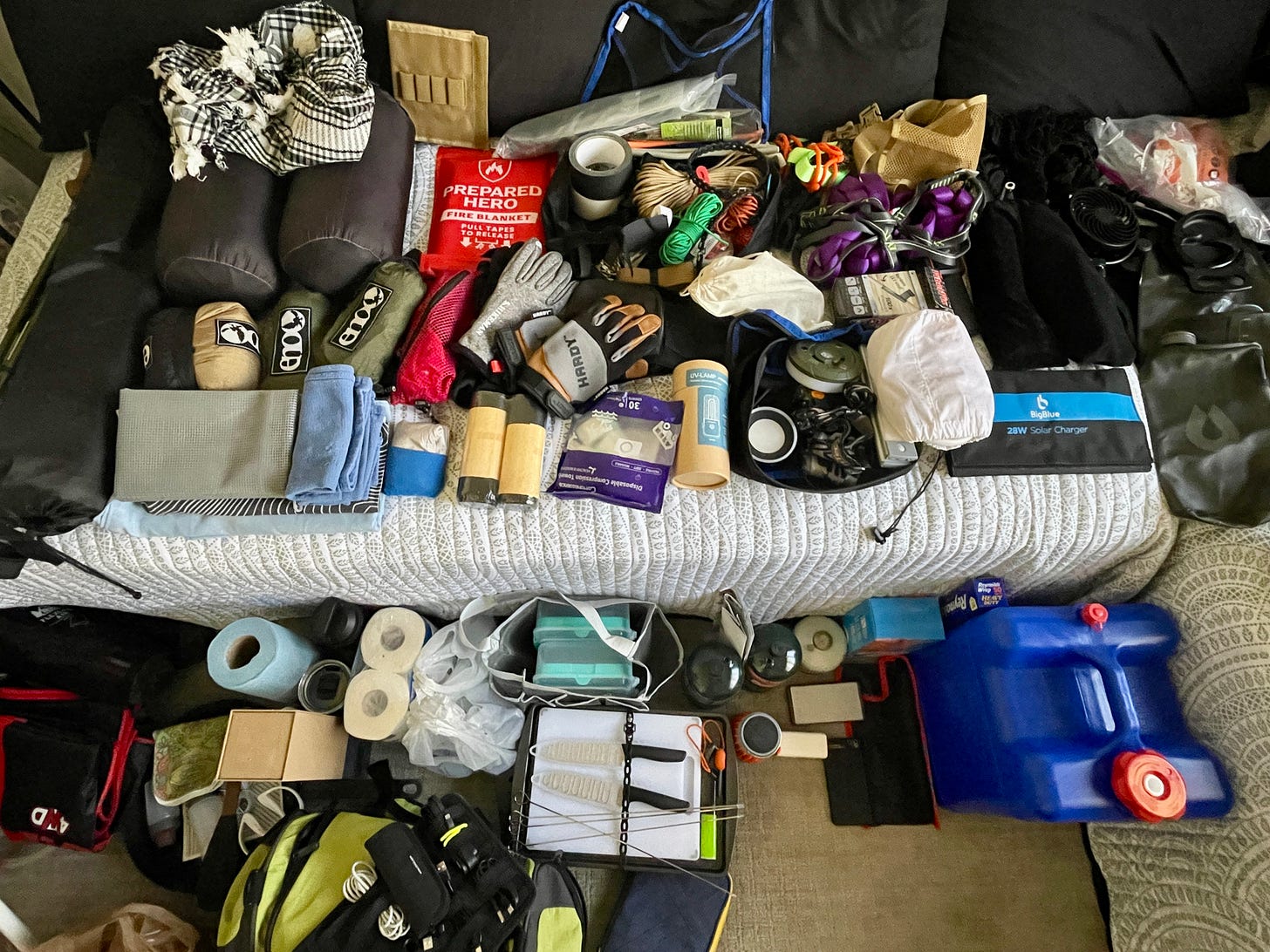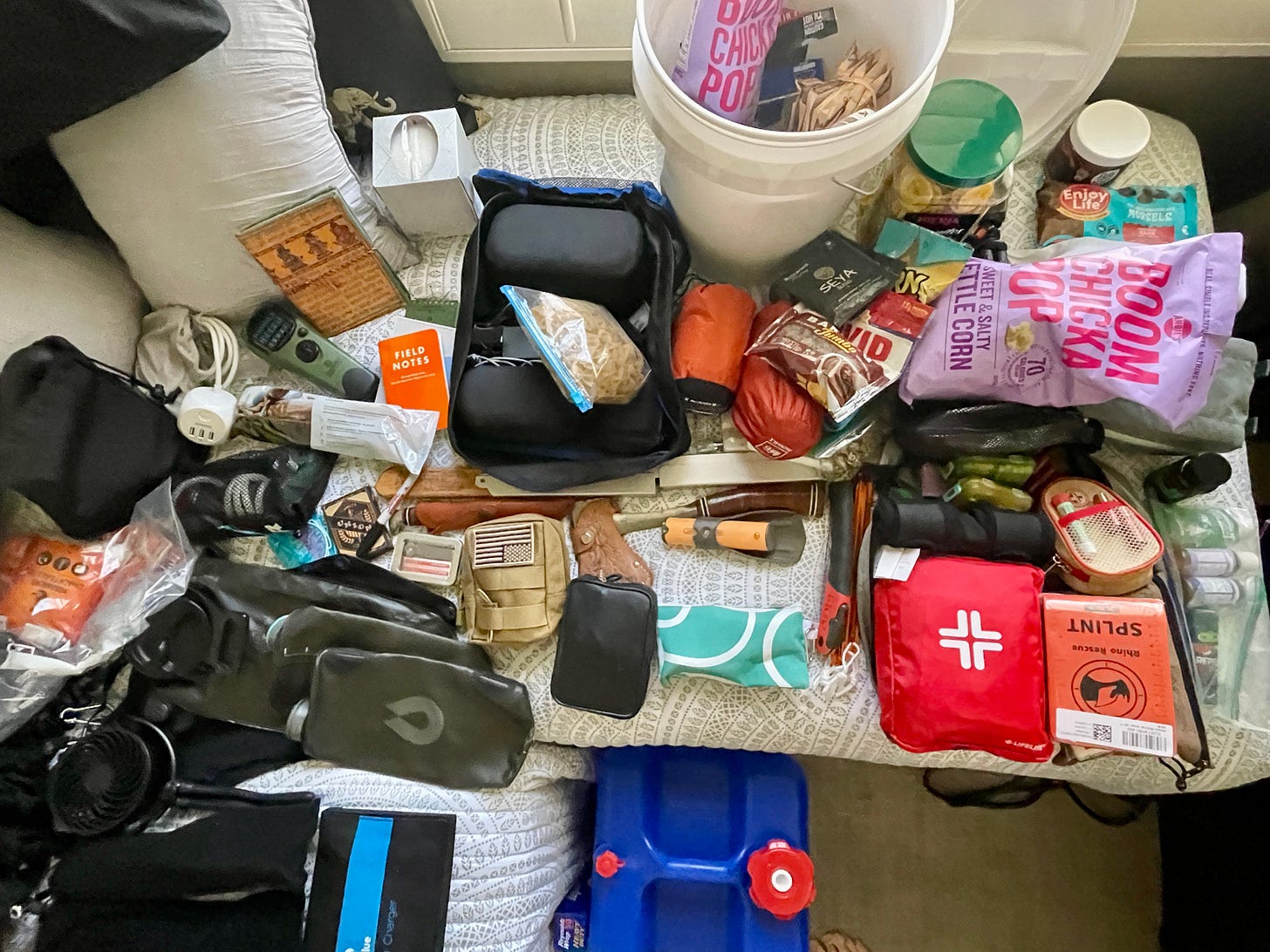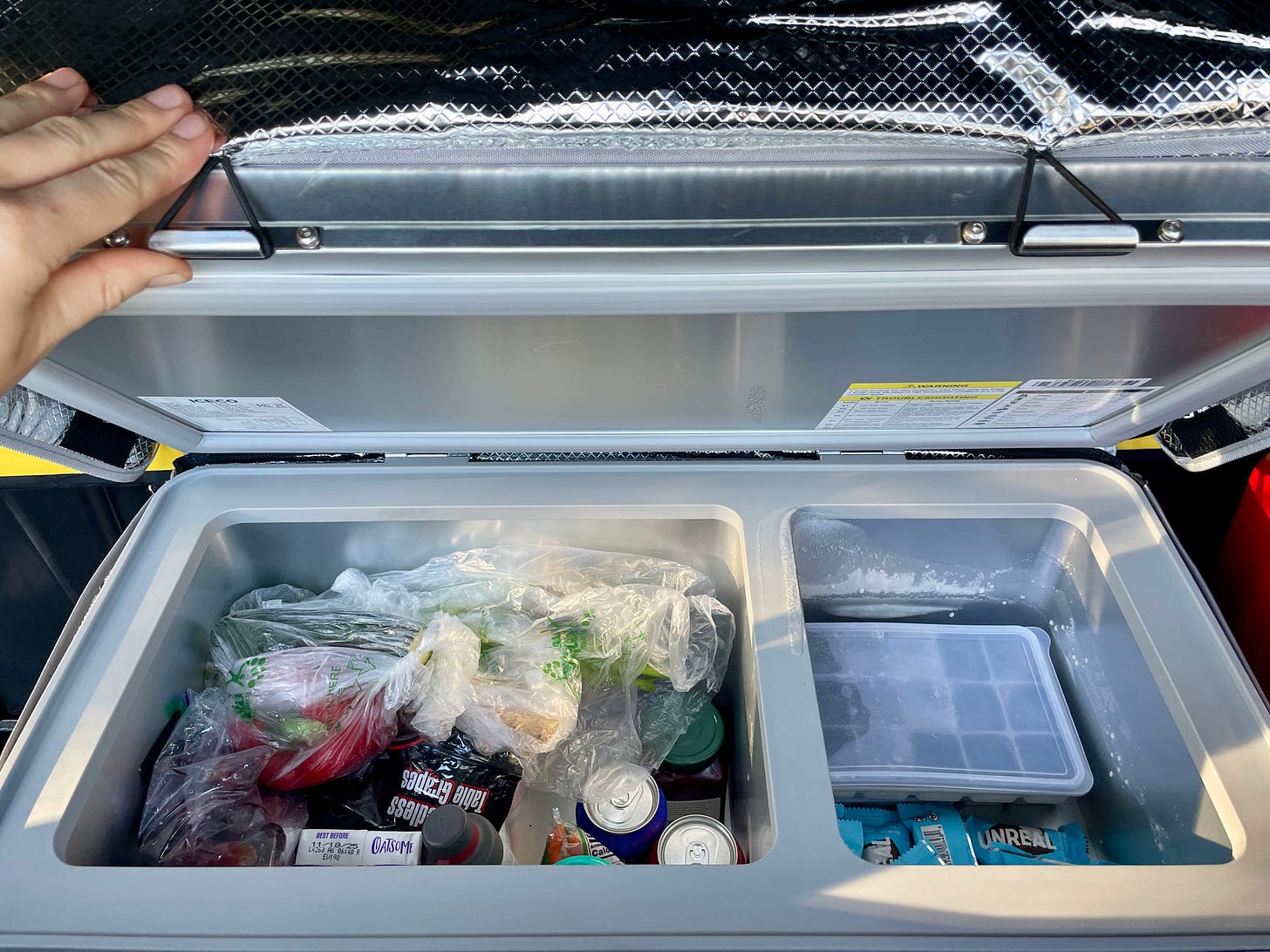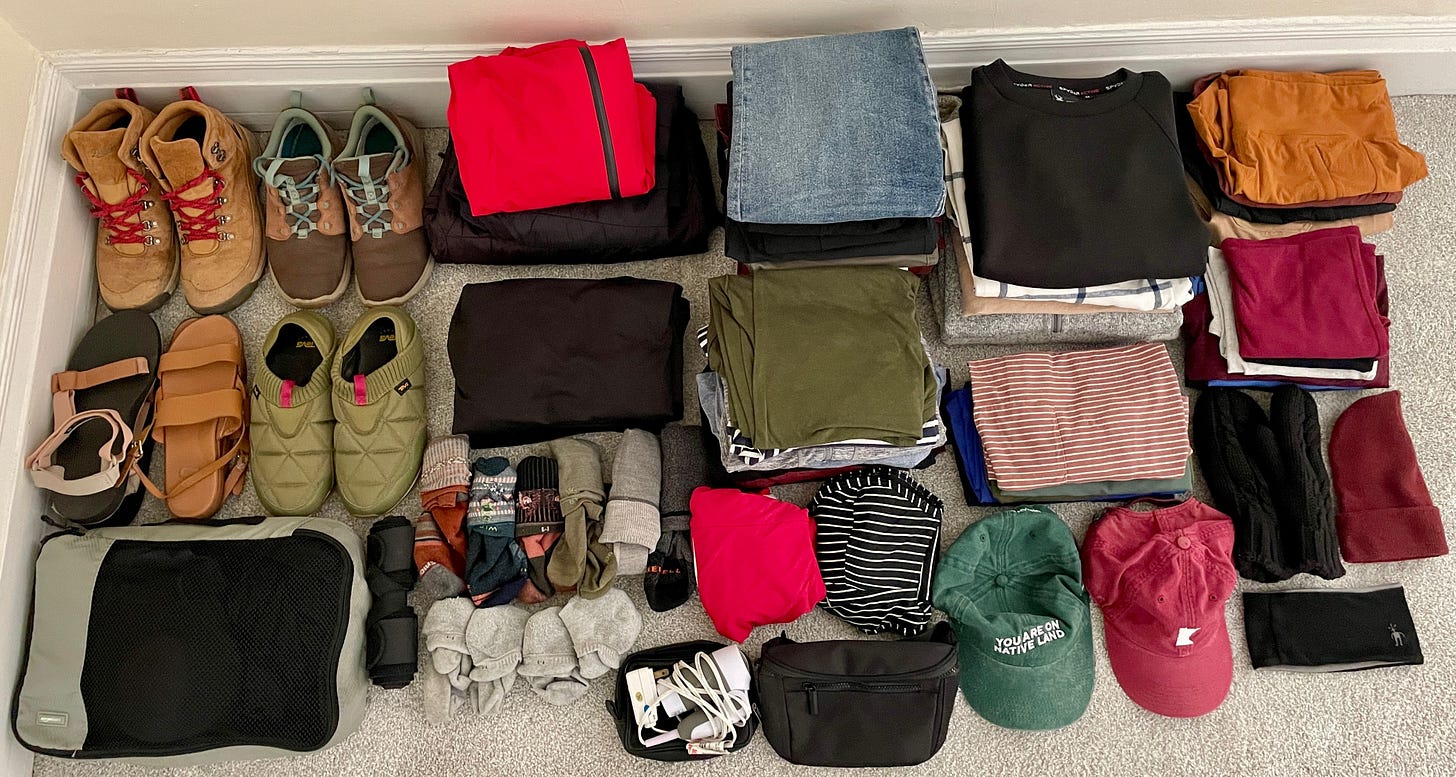With the amount of gear we have gathered for this trip, you would think we were prepping for a year on the road.
But we have been thinking strategically (is anyone who knows Taylor surprised?) about what we pack, purchase, and thrift. Along the way, it’s been helpful for us to break down potential gear into a few camps (so to speak): long-term investments, survival, function, and flourishing.

Long-Term Investments
Our big long-term investments have been the truck and canopy topper, which we plan to use for work, building, and landscaping on a future property site. The rooftop tent was another big expense, but we hope that we enjoy this experience enough to want to continue using the tent for camping on the North Shore and elsewhere afterwards
Another big item we bought and will use every day is an EcoFlow portable power bank with 786wh capacity. This will allow us to power our electronics (we both brought laptops and phones) plus a LED light strip and USB outlets in the tent, a diesel heater, and heated mattress pads. We’ll also be able to use the power bank on a future property as we build out the site, temporarily live off-grid if need be, and charge power tools.
Survival
There are a few items that we wanted for peace of mind (both ours and our mothers’) as we drive out into and camp and hike in remote areas that are far from emergency services, wifi, and cell service.
An EPIRB satellite communication system. Our friend Alan very generously offered to let us use his Garmin InReach hiking GPS for the trip, and we activated a subscription on it that will enable us to send an SOS beacon to emergency services when we are outside of wifi or cell service range. This is one tool that we hope we don’t have to use, but would need if we got lost on a remote hike, the truck broke down, or either of us got seriously hurt and needed extraction.
Wilderness first aid kit, tourniquet, and basic splint. Taylor also found an excellent online wilderness first aid class that is free (if you don’t need a formal certification). We’ve been brushing up on snakebite protocol in particular, as I saw my very first rattlesnake this week (<10 ft away) and they are starting to emerge down here as the temps warm up.
Disposable hand-warmers. The single-use function of these is not ideal, but I have a circulatory condition called Raynaud’s Syndrome, which means that my fingers and toes often and easily get icy cold and go numb. Sometimes these are the only tools that can warm me back up quickly.
A fire extinguisher and fire blanket to keep readily available in the truck.
A 5-gallon Jerry fuel can to throw in the back of the truck, just in case. Honestly, we’re still getting used to needing to stop regularly for gas, as we’re used to driving an EV and a hybrid with 45 MPG. The truck gets 18 MPG.
Two 5-gallon buckets with screw-on, sealing lids. One will be for our dry food goods (pasta, snacks, oatmeal, etc.) and one for our food trash; both need to be airtight to prevent leaks and odors in the truck and to be safe in bear country (even when they are locked inside the truck…yikes)!

Function
This is the gear that will allow us to camp in dispersed and remote areas without access to the services that state/federal/private campsites provide — like potable water, electric hookups, trash, and bathrooms. We could absolutely find ways to get by without these items, but we’re also not looking to “prove” anything with this trip. We know it will be challenging in many ways, and hope it can be comfortable in others.
A 7-gallon water container for drinking, cooking, and dish washing.
I bought a portable female urination device for this trip…after one specific incident on our last car-camping road trip where I was squatting to pee on a remote piece of AZ desert in a dispersed camping area, and Taylor made me laugh really hard, and I TIPPED RIGHT OVER into the dust, narrowly avoiding both a cactus and getting wet.
We also bought a foldable camping toilet that can be used over a hole (that we will dig with a cheap shovel that we picked up at Harbor Freight) or used with biodegradable bags if we need to “pack out.” On our past road trips, we stayed at more campsites with public bathrooms, but with the truck, we’re aiming to camp primarily in remote spots on federal and BLM lands.
Our rooftop tent came with a 2.5” foam mattress, but we upgraded to these heated memory foam pads for extra warmth (expecting to camp in snow and below-freezing temps at times). We’ll top these with insulated Puffer Wolf blankets and a set of cheap sheets and pillows that we picked up in Scottsdale.
A truck fridge! We originally planned to buy a large Yeti cooler to keep food cold for a few days at a time, with bags of ice, but Taylor found a brand new ICECO “truck fridge” at a big discount through a supplier in AZ that didn’t cost too much more than a cooler. We slid it into the back of the truck and can access it through the side panel of the truck topper. Between the EcoFlow power bank and our solar panel, we should be able to keep it running on “eco mode” indefinitely.

One final gear MVP: In addition to the flashlights and headlamps that we flew down with, Taylor bought this tiny magnetic keychain flashlight to attach to the tent zipper pull. The flashlight head is magnetic, so we can grab it quickly and use it to navigate down the tent ladder in the middle of the night if we need to pee or grab something out of the truck. I ribbed him about it at first (do we really need another flashlight??) but it’s turned out to be super useful already. At $15, it was money well spent.
Flourishing
These things are just for fun!
Taylor’s drone equipment and a nice camera.
A big plastic outdoor rug/mat that Taylor’s mom was going to throw away, but we can repurpose for a cheap camp mat to help keep the dust down.
LED twinkle lights to string around camp.
A sketch pad, colored pencils, trip journal, and a big stack of books.

Clothing
It was challenging to figure out what clothes to pack — given that we flew down to temps in the high 90s in Scottsdale, will likely hit snow and sub-freezing nightly temps in the Rockies, and will need rain gear in the Olympic Peninsula. Thankfully, my dad had long instilled in me his packing strategy, tested through many decades of backpacking and back-woods camping: “it’s all about second layers.” So we brought lots of layers! Here’s what I ended up bringing along for our two month trip:

FOOTWEAR: 1 pair of waterproof Danner hiking boots, 1 pair of lightweight hiking shoes, 1 pair of slip-on insulated shoes for wearing around camp, 1 pair of hiking sandals (all Tevas so far), plus 1 pair of fashion sandals in case we ever plan an in-town date night.
JACKETS: 1 lightweight Patagonia puffer jacket and 1 Patagonia rain coat. The bright red rain coat is way too big for me, but it’s my dad’s beloved Patagonia that he had since before I was born. I liked the idea of bringing him with me on our many hikes, and he’d be chuffed that his gear is still holding up.
SECOND LAYERS: 1 Patagonia fleece, 2 flannels, 1 wool sweater, and 2 lightweight sweatshirts.
TOPS: 5 long-sleeves/thermals, 5 tees, and 5 tank tops.
BOTTOMS: 1 pair of jeans, 1 pair of fleece-lined sweatpants, 2 pairs of yoga pants, 3 pairs of hiking pants, and 4 pairs of shorts.
UNDIES: 14 pairs of underwear, 5 sports bras, 7 pairs of hiking/thermal socks, and 4 pairs of athletic socks. We brought hand-washing detergent to be able to do laundry in between laundromat stops, as needed.
ACCESSORIES: 2 baseball hats, 1 beanie, 1 SmartWool headband, 1 pair of warm mittens, 2 swim suits, 1 belt bag, and 1 knee brace (hopefully just in case).
PJS: 2 pairs of fleece-lined long johns, knowing that I could layer on top if needed. Our first night in the tent (before we set up the heated mattress pads or diesel heater) the temps dropped to the low 40s and this is everything I ended up wearing to bed…
If you have read this far, I promise this is the last of our “gear” posts before we get to the good stuff…our actual travels and camp adventures!
I’m writing this post from a brewery in Flagstaff and can’t wait to share pics from our first few days on the road. It’s been an amazing start to the trip, and we are so grateful for those following along and sending their questions, recommendations, and well-wishes our way. Much love, L + T





I love my Danner hiking boots. So great!
I have Raynauds, too. Love some gear recommendations so sharing these bog boots. I got for fashion/waterproofness and can’t live without them now. I wore them all fall, winter, and spring in the garden, running to target, whatever. They don’t get hot, have great treads, and my toes did not go numb once this winter!!!! I can slip them on and off pretty easy. https://www.bogsfootwear.com/shop/style/73042-260.html?gclid=CjwKCAjw_pDBBhBMEiwAmY02NlwSuIZ5d2IVz5ktN51EC84NoKgZXIYaKfxdbQ16sgsLMiv9hkQByhoCm1QQAvD_BwE